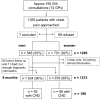Gender differences in presentation and diagnosis of chest pain in primary care
- PMID: 20003406
- PMCID: PMC2801475
- DOI: 10.1186/1471-2296-10-79
Gender differences in presentation and diagnosis of chest pain in primary care
Abstract
Background: Chest pain is a common complaint and reason for consultation in primary care. Research related to gender differences in regard to Coronary Heart Disease (CHD) has been mainly conducted in hospital but not in primary care settings. We aimed to analyse gender differences in aetiology and clinical characteristics of chest pain and to provide gender related symptoms and signs associated with CHD.
Methods: We included 1212 consecutive patients with chest pain aged 35 years and older attending 74 general practitioners (GPs). GPs recorded symptoms and findings of each patient and provided follow up information. An independent interdisciplinary reference panel reviewed clinical data of every patient and decided about the aetiology of chest pain at the time of patient recruitment. Multivariable regression analysis was performed to identify clinical predictors that help to rule in or out CHD in women and men.
Results: Women showed more psychogenic disorders (women 11,2%, men 7.3%, p = 0.02), men suffered more from CHD (women 13.0%, men 17.2%, p = 0.04), trauma (women 1.8%, men 5.1%, p < 0.001) and pneumonia/pleurisy (women 1.3%, men 3.0%, p = 0.04) Men showed significantly more often chest pain localised on the right side of the chest (women 9.1%, men 25.0%, p = 0.01). For both genders known clinical vascular disease, pain worse with exercise and age were associated positively with CHD. In women pain duration above one hour was associated positively with CHD, while shorter pain durations showed an association with CHD in men. In women negative associations were found for stinging pain and in men for pain depending on inspiration and localised muscle tension.
Conclusions: We found gender differences in regard to aetiology, selected clinical characteristics and association of symptoms and signs with CHD in patients presenting with chest pain in a primary care setting. Further research is necessary to elucidate whether these differences would support recommendations for different diagnostic approaches for CHD according to a patient's gender.
References
-
- Klinkman MS, Stevens D, Gorenflo DW. Episodes of care for chest pain: a preliminary report from MIRNET. Michigan Research Network. J Fam Pract. 1994;38:345–52. - PubMed
Publication types
MeSH terms
LinkOut - more resources
Full Text Sources
Medical


